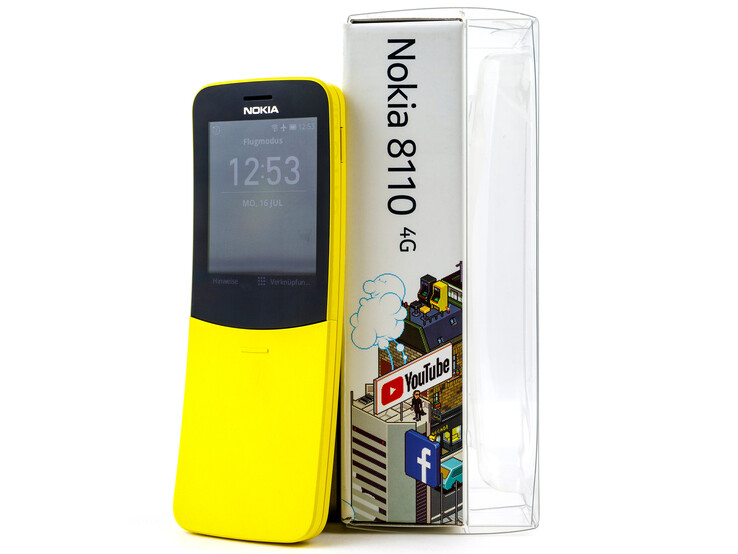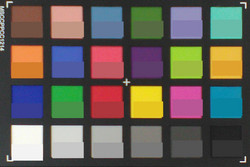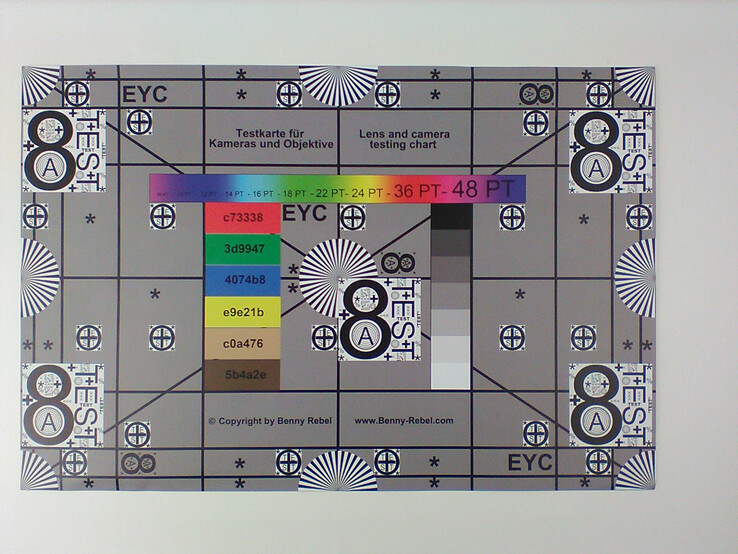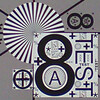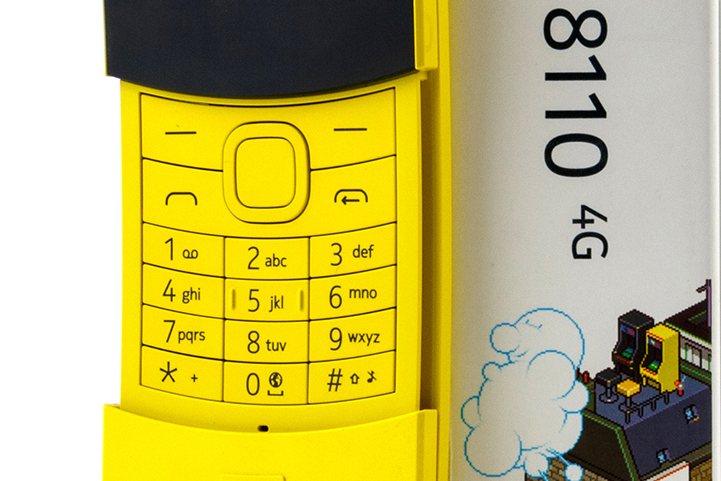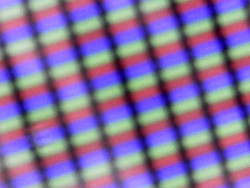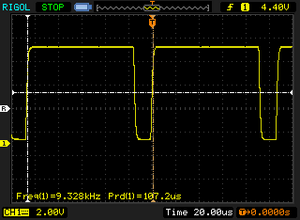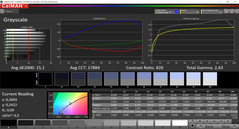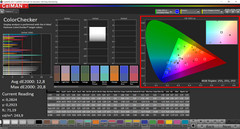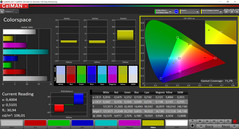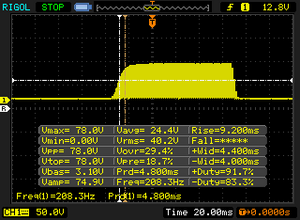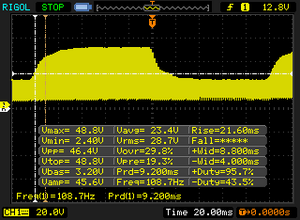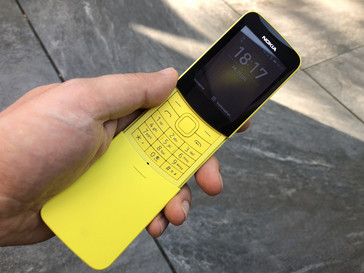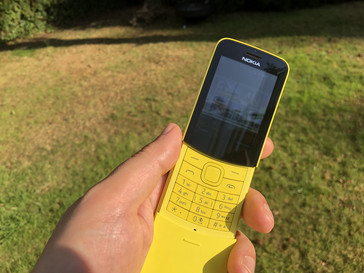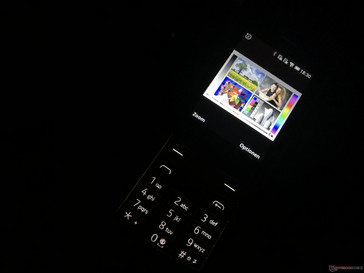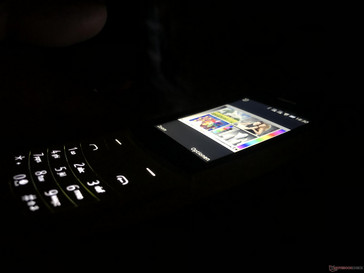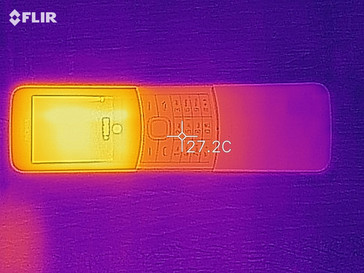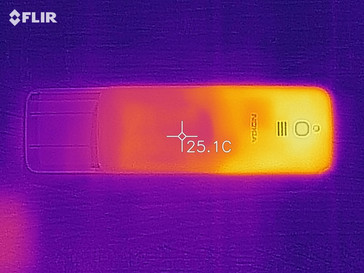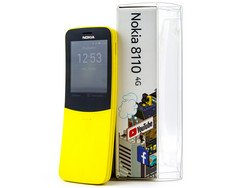Nokia 8110 4G Cell Phone Review
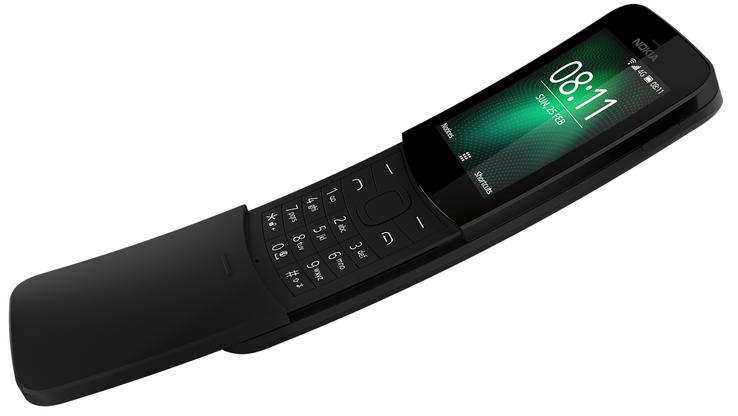
The original Nokia 8110 was first released in 1996, and it was even more chunky than today’s review unit. It was, however, already curved and therefore quickly dubbed bananaphone, and at the time of release it was a true high-end cell phone. The phone became notoriously popular in 1999 thanks to the blockbuster “The Matrix” released that same year. In the movie, the characters were using a modified version of the original 8110, and its spring-mechanism eventually found its way back into the real world with the release of the Nokia 7110.
The question is: can a cell phone such as this still serve its purpose in 2018, a whopping 22 years later? HMD Global seems to think so, and they have spruced up the phone, and made it slimmer and lighter. In addition, it now features a 2.4-inch color display and is based around Qualcomm’s 205 mobile platform which was designed specifically for so-called feature phones. The platform includes modern features such as Wi-Fi, Bluetooth, LTE, and GPS. The 8110’s 4 GB of internal storage can be easily expanded via microSD cards, and the rear-facing camera features a 2 MP sensor. All of this is powered by a 1,500 mAh battery, which is supposed to make for very long battery life, and it can be purchased for around $90.
The 8110 is the first of its kind as we have never had a similar phone in review. Accordingly, the only competitors that we can pitch it against are entry level smartphones such as the LG K4 (2017), the Nokia 1, and the Motorola Moto C.
Case
The Nokia 8110 G4’s curved case is very distinctive, and it is available in two colors: Black and Yellow. Our Yellow review unit’s build quality was immaculate with very consistent gaps. Only under closer inspection did we notice that HMD Global has decided to use two different polycarbonates with differing surface textures. While the top shell is glossy and polished the slider and the rear cover are matte.
Unfortunately, the slider is not spring-loaded and must be operated manually. A magnet ensures proper hold when closed. The rear cover can be completely removed and offers access to the secondary SIM slot (nano). The primary SIM slot (micro) as well as the microSD card are hidden behind the battery.
The device is IP52-certified against dust and water ingress. In other words: it is certified to withstand the weather, but is not fully water or fully dust-proof.
Connectivity
Connectivity was surprisingly abundant, and very similar to entry-level smartphones. Storage can be expanded via microSD card, and the phone supports the most current SDXC standard and therefore all common microSD memory cards.
The MicroUSB 2.0 port at the bottom is used for charging as well as data exchange with computers, and the 3.5-mm headphone jack supports headsets as well.
Even an FM radio receiver is included. The 1,500 mAh battery is user-replaceable and hidden behind the rear cover.
Software
The Nokia 8110 4G’s operating system is a so-called smart feature operating system by KaiOS, and it is limited to the most important features. The preloaded app store only lists a handful of apps - at the time of writing we only found six games, a weather app, and a Twitter client.
Of course a revamped version of the classic “Snake” game is preinstalled on the device. We also found apps for mail, music, photos, a web browser, a calendar, Google Assistant, Google Maps, and YouTube. However, you should not expect too much of these Google apps: while YouTube opened and loaded a mobile front page that looked surprisingly good on the tiny display, the search did not work. Getting directions in Google Maps resulted in a manual step-by-step description of the route.
Thus, do not expect too much of the Nokia 8110 4G’s software - it only covers the absolute basics, and the supposedly useful Google apps turned out to be poor ports thereof.
Communication and GPS
A big difference between today’s review unit and the original device is communication: unlike the original 8110, the 4G supports more than just 2G networks. And while 2G and 3G network support is mediocre at best, 4G/LTE support is comparatively decent and covers the most important European bands. However, traveling abroad will be challenging given that HMD Global has decided to sell various regional variants of the device. Our review unit’s LTE Cat. 4 modem was capable of receiving data at up to 150 Mbps. This becomes particularly interesting once you realize that the Nokia 8110 supports tethering and can therefore be used as portable hot spot.
The Wi-Fi module is nothing to write home about and only supports 802.11b/g/n in the 2.4 GHz band. Unfortunately, we were unable to run any benchmarks due to lack of application support. Based on previous experience we would expect the SoC to achieve somewhere between 40 - 50 Mbps. During our test period, Wi-Fi reception and range were quite decent.
Bluetooth 4.1 may not be the most recent standard, but at least it is widely supported. In addition to wireless speakers and headphones it can also connect to a car’s intercom. It worked remarkably well in our test when connected to a Volkswagen Golf. NFC is not supported.
Location services are limited to GPS and A-GPS only. GPS lock was obtained fairly quickly, and the preloaded Google Maps app had no trouble accurately displaying our current location.
Telephony and Call Quality
Making phone calls with the Nokia 8110 4G is as simple as it gets: type the number and press the dial button - done. Alternatively, you can also initiate phone calls from the address book. The device supports contact synchronization with Google and Outlook accounts to spare you manual entry. We have not experienced any problem synchronizing with Google at all. Outlook synchronization, however, turned out to be very unreliable. Sometimes random contacts were missing names, other times entries were missing completely.
The call quality was superb, particularly considering the phone supports VoLTE. That said, the included headset should be considered a makeshift solution given the fact that the microphone was very sensitive to wind.
Camera
IIt is very obvious that HMD Global has not focused on the camera with its latest feature phone. It entirely lacks a front-facing camera and the rear-facing main shooter is a meager 2 MP sensor. Accordingly, photos were lacking in detail and rather blurry. Entry-level smartphones such as the LG K4 are equipped with much better cameras. Unsurprisingly, the camera did even worse in low-light conditions, but it did have a better noise ratio than the LG’s camera.
Videos are recorded in 720x480, but the camera turned out to be incapable of dealing with back light and thus overexposed massively. In return, recorded sound quality was excellent.
As usual, we have also tested the camera under normalized conditions. Colors were somewhat oversaturated and brown colors had a distinct red tint. White balance was on the warm side.
The test chart photo is perfect to illustrate exactly where the camera has failed us. The sensor’s low resolution is reflected in the low level of overall details, although it was acceptable dead center. The photo gets increasingly blurry towards the edges, and chromatic aberrations become visible around the outlines.
Accessories and Warranty
In addition to the Nokia 8110 4G itself the only items included in the box are a charger with fixed USB cable, a headset, and a quick start guide in nine different languages.
Default warranty for devices sold in Europe is 24 months. Please see our Guarantees, Return policies and Warranties FAQ for country-specific information.
Input Devices & Handling
Handling has pretty much remained unchanged. In addition to the backlit physical keyboard a single power button is located on the right-hand side. The phone does not have a touchscreen.
In order to access the keyboard the slider has to be slid downwards. Unfortunately, the new iteration of the legendary bananaphone lacks a spring-loaded slider and it must therefore be operated manually. The buttons themselves are fairly small but our accuracy improved significantly after a short period of familiarization. Key travel is comfortable and feedback is very precise and accurate. The four directional buttons are required for navigating the menus, which left us with a mix of nostalgia and bedevilment. Fortunately, you can configure quick access items on the start screen.
The 8110 also supports a screen lock to protect the phone from unwanted access with a four digit PIN code.
Display
The Nokia 8110 4G’s seemingly curved display is an optical illusion. The display itself is completely flat but the glass atop of it is not, resulting in the curved effect. The panel is neither particularly large (2.45 inches, 4:3) nor with high resolution (320x240). At just 257 nits it also turned out to be comparatively dark. Accordingly, while its black level was more than decent, the resulting contrast ratio was still substandard.
We were able to detect PWM flickering at a very high frequency. Thus, it should not cause any problems.
| |||||||||||||||||||||||||
Center on Battery: 257 cd/m²
Contrast: 857:1 (Black: 0.3 cd/m²)
ΔE ColorChecker Calman: 12.8 | ∀{0.5-29.43 Ø4.77}
ΔE Greyscale Calman: 15.1 | ∀{0.09-98 Ø5}
73.2% sRGB (Calman 2D)
Gamma: 2.43
CCT: 17884 K
| Nokia 8110 4G TFT, 320x240, 2.5" | LG K4 2017 854x480, 5" | LG K9 IPS, 1280x720, 5" | Lenovo Moto C TFT, 854x480, 5" | Nokia 1 IPS, 854x480, 4.5" | |
|---|---|---|---|---|---|
| Screen | 34% | 8% | 21% | 64% | |
| Brightness middle (cd/m²) | 257 | 385 50% | 282 10% | 364 42% | 256 0% |
| Black Level * (cd/m²) | 0.3 | 0.35 -17% | 0.58 -93% | 0.31 -3% | 0.12 60% |
| Contrast (:1) | 857 | 1100 28% | 486 -43% | 1174 37% | 2133 149% |
| Colorchecker dE 2000 * | 12.8 | 6.2 52% | 5.6 56% | 10.4 19% | 4.82 62% |
| Colorchecker dE 2000 max. * | 20.8 | 12.6 39% | 10.5 50% | 18 13% | 11.75 44% |
| Greyscale dE 2000 * | 15.1 | 7 54% | 4.6 70% | 12.7 16% | 5.2 66% |
| Gamma | 2.43 91% | 2.08 106% | 2.29 96% | 2.04 108% | 2.3 96% |
| CCT | 17884 36% | 8257 79% | 7333 89% | 12904 50% | 7107 91% |
| Brightness (cd/m²) | 372 | 271 | 355 | 251 | |
| Brightness Distribution (%) | 92 | 93 | 92 | 89 |
* ... smaller is better
Screen Flickering / PWM (Pulse-Width Modulation)
| Screen flickering / PWM detected | 9328 Hz | ||
The display backlight flickers at 9328 Hz (worst case, e.g., utilizing PWM) . The frequency of 9328 Hz is quite high, so most users sensitive to PWM should not notice any flickering. In comparison: 53 % of all tested devices do not use PWM to dim the display. If PWM was detected, an average of 8084 (minimum: 5 - maximum: 343500) Hz was measured. | |||
We test every single display using a spectrophotometer in combination with the CalMAN software. Grayscale had a very obvious blue tint, which resulted in a rather cool picture, but had no negative effects otherwise due to the overall pale color representation.
Colors were also noticeably distorted, and color deviations were massive. The color space coverage was very small, particularly reds.
Display Response Times
| ↔ Response Time Black to White | ||
|---|---|---|
| 18.4 ms ... rise ↗ and fall ↘ combined | ↗ 9.2 ms rise | |
| ↘ 9.2 ms fall | ||
| The screen shows good response rates in our tests, but may be too slow for competitive gamers. In comparison, all tested devices range from 0.1 (minimum) to 240 (maximum) ms. » 40 % of all devices are better. This means that the measured response time is similar to the average of all tested devices (20.2 ms). | ||
| ↔ Response Time 50% Grey to 80% Grey | ||
| 43.2 ms ... rise ↗ and fall ↘ combined | ↗ 21.6 ms rise | |
| ↘ 21.6 ms fall | ||
| The screen shows slow response rates in our tests and will be unsatisfactory for gamers. In comparison, all tested devices range from 0.165 (minimum) to 636 (maximum) ms. » 71 % of all devices are better. This means that the measured response time is worse than the average of all tested devices (31.6 ms). | ||
The Nokia 8110 4G did not do particularly well outdoors, especially considering its low maximum brightness, the poor contrast ratio, and the curved display. These factors rendered it virtually unusable in the sun, and it was even challenging in the shade on bright sunny days.
Due to the lack of an ambient light sensor the display brightness had to be adjusted manually.
Nokia 8110 4G viewing angles
Performance
The Nokia 8110 4G is powered by a Qualcomm 205 SoC that has been specifically developed for feature phones like this, and is closely related to the Snapdragon 210. It features a 1.1 GHz dual-core CPU backed by 512 MB of RAM and an Adreno 304 GPU. At just 4 GB, storage space capacity is less than some smartphones have in RAM capacity.
Fortunately the operating system is not particularly demanding, and the SoC’s power is sufficient despite the occasional stalls. Launching apps or scanning the gallery for photos always took quite some time.
Browsing the web is supported by the Nokia cell phone. The browser was even capable of rendering and correctly displaying complex websites in a timely manner. Navigation, however, was fairly complicated and required frequent adjustment of the zoom level in order to locate elements first and then select them.
Gaming
At the time of writing, the KaiOS app store listed a total of six free games. In addition, the classic Nokia game “Snake” is preinstalled on the 8110 in a spiced up color edition retaining the classic 8-bit look.
None of the available games were particularly challenging, but they were certainly entertaining. They ran smoothly on the 8110 and controls via keyboard worked flawlessly.
Emissions
Temperature
Surface temperatures were low at all times, and the phone did not even get lukewarm when idle. Given that we were unable to run our usual test suite of applications on the 8110, we decided to simulate load by using the camera app. It seemed to cause the highest load and heat up the phone the most. Even under load temperatures remained unobtrusive and low.
(+) The maximum temperature on the upper side is 33 °C / 91 F, compared to the average of 35.2 °C / 95 F, ranging from 21.9 to 247 °C for the class Smartphone.
(+) The bottom heats up to a maximum of 33.7 °C / 93 F, compared to the average of 34 °C / 93 F
(+) In idle usage, the average temperature for the upper side is 26.4 °C / 80 F, compared to the device average of 32.9 °C / 91 F.
Speaker
The single speaker on the 8110’s backside can get surprisingly loud. Unfortunately, its sound characteristics were not well balanced. Highs were very pronounced and clear, which is understandable given the focus on telephony and call quality, but mids and lows were somewhere between underrepresented and nonexistent.
The integrated FM radio tuner worked great. It has an automatic station seek mode and a list of favorites, and while it requires a connected headset to be used as antenna, sound output can be redirected to the internal speaker instead.
Other than that the only form of music the Nokia 8110 4G supports is offline music that has be physically present as an audio file on the phone itself. It lacks support for HD audio, and the list of supported formats is somewhat short (AAC, AMR, MP3, MIDI, Vorbis). High bitrate MP3 files worked flawlessly, and the preinstalled audio app can filter these out and even display them with their respective cover. Volume is controlled by the directional buttons used for navigation.
In addition to Bluetooth speakers the phone also supports directly connected 3.5-mm headphones or speakers, and its analog audio output was very clear. Occasionally, we were able to hear a very quiet background static. The included headset was very cheap, and its sound quality was very poor.
Nokia 8110 4G audio analysis
(+) | speakers can play relatively loud (88.3 dB)
Bass 100 - 315 Hz
(-) | nearly no bass - on average 43.8% lower than median
(±) | linearity of bass is average (8% delta to prev. frequency)
Mids 400 - 2000 Hz
(±) | reduced mids - on average 6.4% lower than median
(±) | linearity of mids is average (7.5% delta to prev. frequency)
Highs 2 - 16 kHz
(+) | balanced highs - only 4.5% away from median
(+) | highs are linear (2.1% delta to prev. frequency)
Overall 100 - 16.000 Hz
(±) | linearity of overall sound is average (26.5% difference to median)
Compared to same class
» 68% of all tested devices in this class were better, 5% similar, 27% worse
» The best had a delta of 11%, average was 35%, worst was 134%
Compared to all devices tested
» 81% of all tested devices were better, 4% similar, 15% worse
» The best had a delta of 4%, average was 24%, worst was 134%
LG K4 2017 audio analysis
(+) | speakers can play relatively loud (86.5 dB)
Bass 100 - 315 Hz
(-) | nearly no bass - on average 38.2% lower than median
(±) | linearity of bass is average (7.6% delta to prev. frequency)
Mids 400 - 2000 Hz
(±) | reduced mids - on average 7% lower than median
(±) | linearity of mids is average (9.3% delta to prev. frequency)
Highs 2 - 16 kHz
(+) | balanced highs - only 4.5% away from median
(+) | highs are linear (5.2% delta to prev. frequency)
Overall 100 - 16.000 Hz
(±) | linearity of overall sound is average (26.7% difference to median)
Compared to same class
» 68% of all tested devices in this class were better, 6% similar, 26% worse
» The best had a delta of 11%, average was 35%, worst was 134%
Compared to all devices tested
» 81% of all tested devices were better, 4% similar, 15% worse
» The best had a delta of 4%, average was 24%, worst was 134%
Power Management
Power Consumption
Power consumption was very low, which tends to be a big advantage of feature phones. We were, however, surprised by the display’s comparatively high power consumption at minimum brightness. Based on its size, we would have expected a lower overall consumption. However, standby battery life was excellent. Subjectively, the phone seemed to last forever on a single charge.
Charging the battery from near empty to full took around 100 minutes.
| Off / Standby | |
| Idle | |
| Load |
|
Key:
min: | |
| Nokia 8110 4G 1500 mAh | LG K4 2017 2500 mAh | Nokia 1 2150 mAh | LG K9 2500 mAh | Average Qualcomm 205 | Average of class Smartphone | |
|---|---|---|---|---|---|---|
| Power Consumption | -43% | -120% | -161% | -9% | -233% | |
| Idle Minimum * (Watt) | 0.53 | 0.64 -21% | 0.9 -70% | 0.54 -2% | 0.565 ? -7% | 0.847 ? -60% |
| Idle Average * (Watt) | 0.77 | 1.14 -48% | 1.5 -95% | 2.09 -171% | 0.835 ? -8% | 1.445 ? -88% |
| Idle Maximum * (Watt) | 0.8 | 1.25 -56% | 2 -150% | 2.2 -175% | 0.95 ? -19% | 1.629 ? -104% |
| Load Average * (Watt) | 1.49 | 2.26 -52% | 3.5 -135% | 4.93 -231% | 1.595 ? -7% | 6.97 ? -368% |
| Load Maximum * (Watt) | 1.73 | 2.36 -36% | 4.3 -149% | 5.68 -228% | 1.815 ? -5% | 11.2 ? -547% |
* ... smaller is better
Battery Life
The 1,500 mAh battery is more than sufficient for great battery life. Long standby battery life is certainly a big plus, although the phone discharged rather quickly once we actually began using it.
It lasted for slightly over 8 hours in our Wi-Fi test. In addition to CPU and GPU, which were more strained by this test than on smartphones with more powerful SoCs, the communication modules also did their fair share of electricity gobbling. We used the 8110 as mobile hot spot regularly during our review period, and the battery drained at a rate of around 15% per hour.
Heavy users will most probably not squeeze the greatest runtimes out of the 8110. However, it does have a distinct advantage over its predecessor: it can be charged using a small power bank.
| Nokia 8110 4G 1500 mAh | Lenovo Moto C 2350 mAh | LG K4 2017 2500 mAh | Nokia 1 2150 mAh | LG K9 2500 mAh | |
|---|---|---|---|---|---|
| Battery runtime | 5% | 23% | 12% | -28% | |
| WiFi v1.3 (h) | 8.2 | 8.6 5% | 10.1 23% | 9.2 12% | 5.9 -28% |
| Reader / Idle (h) | 19.3 | ||||
| H.264 (h) | 8.8 | ||||
| Load (h) | 4.6 |
Pros
Cons
Verdict
Bringing back the Nokia 8110 is certainly a noteworthy coup even though it will not make anyone ditch their smartphones in favor of the bananaphone. It is much more likely for it to serve as a secondary device. Its benefits include long standby battery life and an amazing call quality. Battery life was decent, however the camera was more of a gimmick than an actual camera.
The MicroUSB port is very useful as it can be easily used to top up the device anywhere. It is definitely an advantage that HMD Global has opted against the nostalgic proprietary connectors and in favor of a modern port despite the many intercoms that are still out there.
The Nokia 8110 4G has a very distinct appearance, it combines great telephone features and call quality, including VoLTE.
App selection, on the other hand, was a massive drawback. Generally speaking KaiOS seemed to be somewhat complicated to use, and importing address book data did not always work as expected. Navigation was also fairly complicated and anything but comfortable. Due to a lack of modern messenger app, texting was only supported via SMS.
Still, we liked the Nokia 8110 4G a lot. If you do not want (or need) a smartphone or if you are looking for an affordable secondary phone for those special occasions (for example festivals, or going to the pool) the 8110 is a great feature phone whose biggest drawback is its slightly too dark display.
Nokia 8110 4G
- 07/23/2018 v6 (old)
Daniel Schmidt




